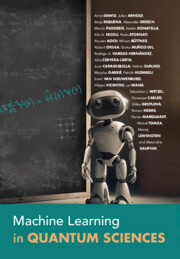Book contents
- Frontmatter
- Dedication
- Contents
- Contributors
- Preface
- Acknowledgments
- Note on the text
- Abbreviations
- 1 Introduction
- 2 Basics of machine learning
- 3 Phase classification
- 4 Gaussian processes and other kernel methods
- 5 Neural-network quantum states
- 6 Reinforcement learning
- 7 Deep learning for quantum sciences: Selected topics
- 8 Physics for deep learning
- 9 Conclusion and outlook
- A Mathematical details on principal component analysis
- B Derivation of the kernel trick
- C Choosing the kernel matrix as the covariance matrix for a Gaussian process
- References
- Index
- References
References
Published online by Cambridge University Press: 13 June 2025
- Frontmatter
- Dedication
- Contents
- Contributors
- Preface
- Acknowledgments
- Note on the text
- Abbreviations
- 1 Introduction
- 2 Basics of machine learning
- 3 Phase classification
- 4 Gaussian processes and other kernel methods
- 5 Neural-network quantum states
- 6 Reinforcement learning
- 7 Deep learning for quantum sciences: Selected topics
- 8 Physics for deep learning
- 9 Conclusion and outlook
- A Mathematical details on principal component analysis
- B Derivation of the kernel trick
- C Choosing the kernel matrix as the covariance matrix for a Gaussian process
- References
- Index
- References
Information
- Type
- Chapter
- Information
- Machine Learning in Quantum Sciences , pp. 265 - 305Publisher: Cambridge University PressPrint publication year: 2025
